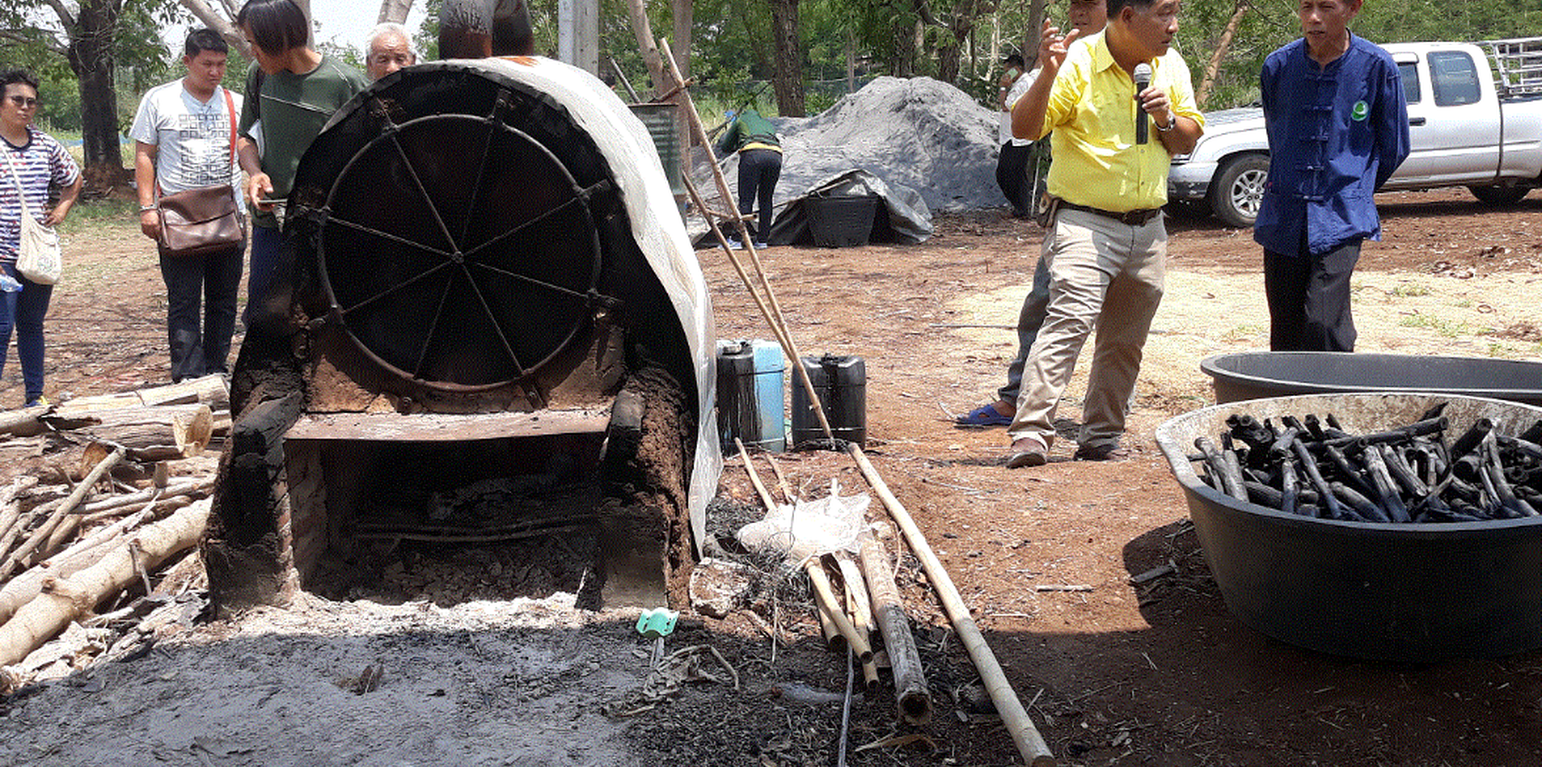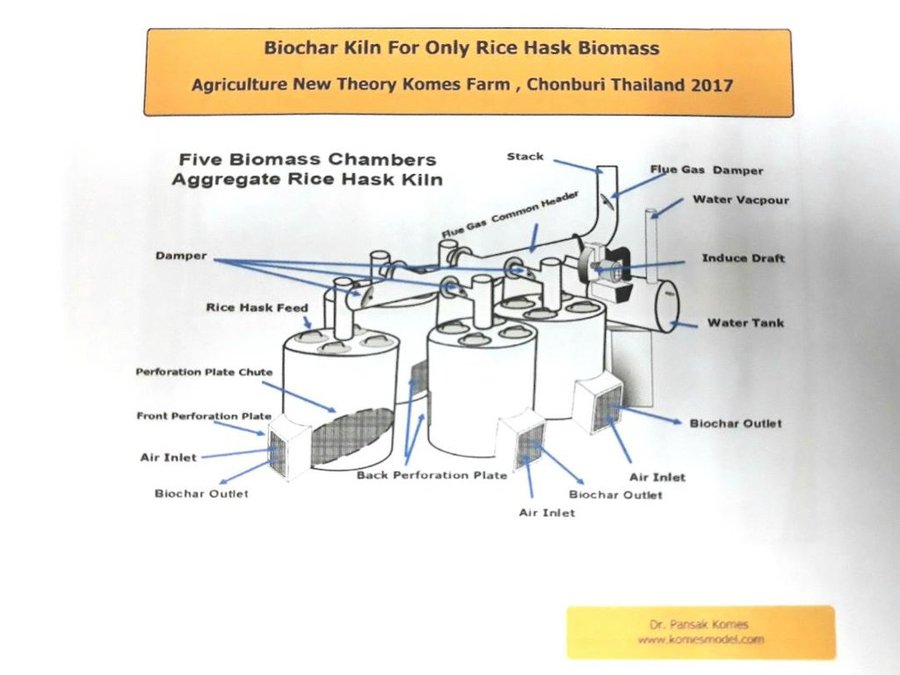Biochar application for land improvement
(ไทย)
Biochar application for land improvement
คำอธิบาย
Biological charcoal, or biochar, is porous charcoal obtained from biomass. Biochar as a soil amendment helps improve soil fertility as well as sequestering carbon in the soil.
Biological charcoal or biochar is porous charcoal obtained from biomass. To obtain biochar, biomass is loaded into a kiln that can be heated to very high temperature (higher than 500 degrees Farenheit). The biomass goes through a process of biodegradation called pyrolysis. After a few hours, this biomass is converted into a coal-like substance, which farmers can use as a soil amendment. Biochar is an alternative way to solve the problems of the environment such as healthy soils, food production and global warming reduction.
Such charcoal production is a technology that can be conducted from the level of farmers to the level of industries. Lehmann and Joseph (2009) collated research work related to the properties of biochar. It was found that biochar had a property of neutrality to alkalinity. It is porous, can hold water and has a composition of elements such as phosphorus, potassium and calcium - but especially carbon. Their findings indicated that biochar can absorb nutrients well, can withstand biological and chemical decomposition and promote activities of microorganisms in the soil. In addition to this biochar, through its positive effect on carbon sequestration, is another way to reduce the emission of carbon to the atmosphere - which is the cause of climate change through the greenhouse effect. Carbon is effectively locked in the biochar and not released. Much research has found that biochar is suitable for agricultural application. It improves soil properties physically, chemically and biologically. To work with biochar, we need a biochar kiln to produce it.
สถานที่
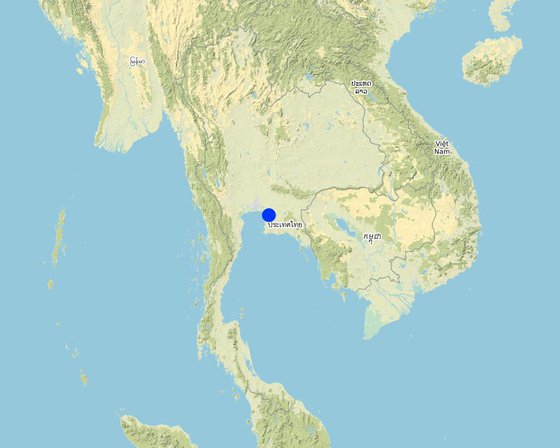
สถานที่: Bor Kwang Tong District, Chonburi province, Chonburi province, ไทย
ตำนวนการวิเคราะห์เทคโนโลยี: 2-10 แห่ง
ตำแหน่งทางภูมิศาสตร์ของสถานที่ที่ถูกเลือ
การเผยแพร่ของเทคโนโลยี: กระจายไปอย่างสม่ำเสมอในพื้นที่ (approx. 1-10 ตร.กม.)
In a permanently protected area?: ไม่ใช่
วันที่ในการดำเนินการ: น้อยกว่า 10 ปี (ไม่นานนี้)
ประเภทของการแนะนำ
-
ด้วยการริเริ่มของผู้ใช้ที่ดินเอง
-
เป็นส่วนหนึ่งของระบบแบบดั้งเดิมที่ทำก้นอยู่ (> 50 ปี)
-
ในช่วงการทดลองหรือการทำวิจัย
-
ทางโครงการหรือจากภายนอก

Biochar being produced from rice husks (Dr.Bunjirtluk Jintaridth)
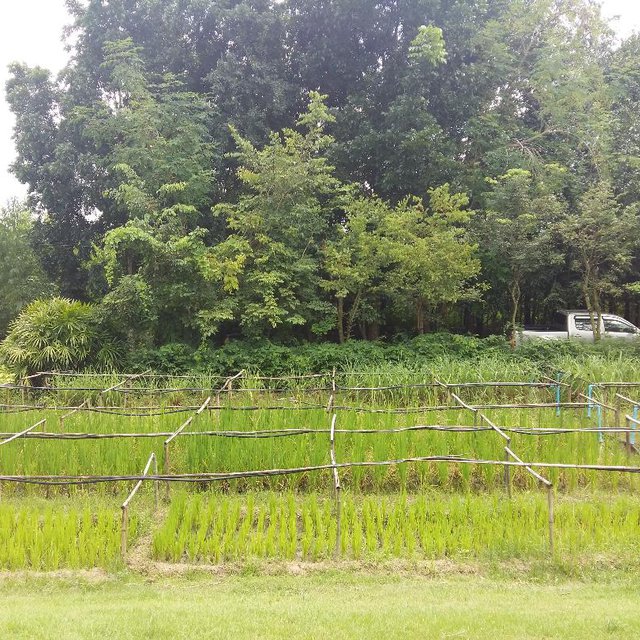
Comparing rice production with, and without biochar, for soil improvement (Dr.Pansak Komes)
จุดประสงค์หลัก
-
ปรับปรุงการผลิตให้ดีขึ้น
-
ลด ป้องกัน ฟื้นฟู การเสื่อมโทรมของที่ดิน
-
อนุรักษ์ระบบนิเวศน์
-
ป้องกันพื้นที่ลุ่มน้ำ/บริเวณท้ายน้ำ โดยร่วมกับเทคโนโลยีอื่นๆ
-
รักษาสภาพหรือปรับปรุงความหลากหลายทางชีวภาพ
-
ลดความเสี่ยงของภัยพิบัติ
-
ปรับตัวเข้ากับการเปลี่ยนแปลงภูมิอากาศของโลก สภาพภูมิอากาศที่รุนแรงและผลกระทบ
-
ชะลอการเปลี่ยนแปลงภูมิอากาศของโลกและผลกระทบ
-
สร้างผลกระทบทางด้านเศรษฐกิจที่เป็นประโยชน์
-
สร้างผลกระทบทางด้านสังคมที่เป็นประโยชน์
การใช้ที่ดิน
Land use mixed within the same land unit: ใช่ - วนเกษตร (Agroforestry)
-
พื้นที่ปลูกพืช
- การปลูกพืชล้มลุกอายุปีเดียว: cereals - rice (wetland). Cropping system: Vegetables - wheat/barley/oat/upland rice
จำนวนของฤดูเพาะปลูกต่อปี: 2
Is intercropping practiced? ใช่
Is crop rotation practiced? ใช่
การใช้น้ำ
-
จากน้ำฝน
-
น้ำฝนร่วมกับการชลประทาน
-
การชลประทานแบบเต็มรูปแบบ
ความมุ่งหมายที่เกี่ยวข้องกับการเสื่อมโทรมของที่ดิน
-
ป้องกันความเสื่อมโทรมของที่ดิน
-
ลดความเสื่อมโทรมของดิน
-
ฟื้นฟูบำบัดที่ดินที่เสื่อมโทรมลงอย่างมาก
-
ปรับตัวกับสภาพความเสื่อมโทรมของที่ดิน
-
ไม่สามารถใช้ได้
ที่อยู่ของการเสื่อมโทรม
-
การเสื่อมโทรมของดินทางด้านเคมี - Ca (Acidification): การเกิดกรด, Cp (Soil pollution): มลพิษในดิน
-
การเสื่อมโทรมของดินทางด้านกายภาพ - Pc (Compaction): การอัดแน่น, Pk (Slaking and crusting): การอุดตันของช่องว่างในดินหรือรูพรุน, Pi (Soil sealing)
กลุ่ม SLM
-
การจัดการป่าธรรมชาติและกึ่งธรรมชาติ
-
การปลูกป่าร่วมกับพืช
-
การจัดการความอุดมสมบรูณ์ของดินแบบผสมผสาน
มาตรการ SLM
-
มาตรการจัดการพืช - A2: อินทรียวัตถุในดิน/ความอุดมสมบูรณ์ในดิน, A6: Residue management (A 6.1: burned)
-
มาตรการอนุรักษ์ด้วยวิธีพืช - V1: ต้นไม้และพุ่มไม้คลุมดิน
-
มาตรการอนุรักษ์ด้วยการจัดการ - M6: การจัดการของเสีย (การทำ รีไซเคิล การเอากลับมาใช้ใหม่หรือการลดปริมาณ)
แบบแปลนทางเทคนิค
ข้อมูลจำเพาะด้านเทคนิค
Biochar kiln for rice husk biomass
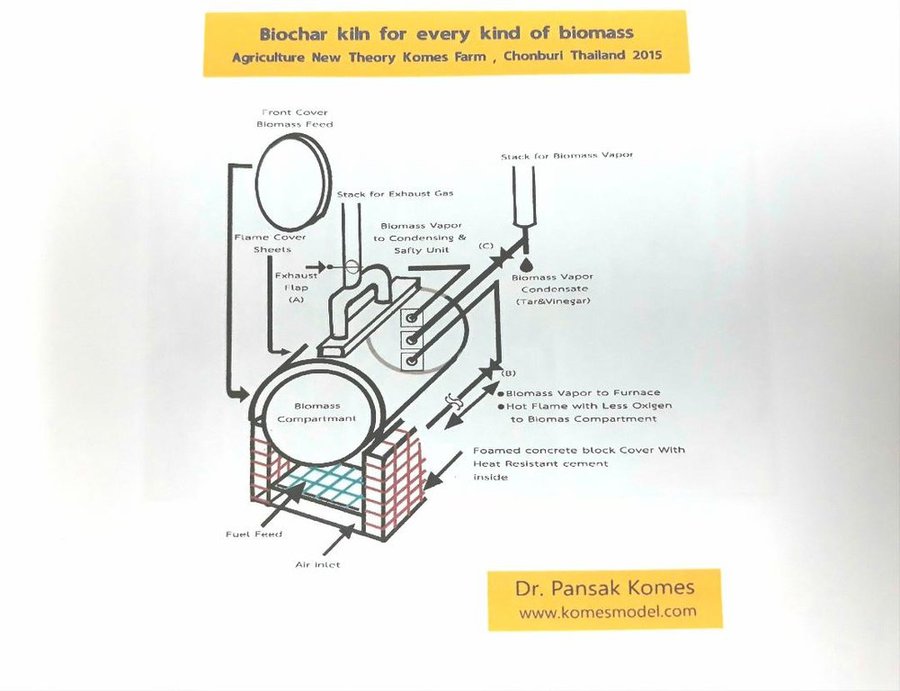
Author: Dr.Pansak Komes
การจัดตั้งและการบำรุงรักษา: กิจกรรม ปัจจัยและค่าใช้จ่าย
การคำนวนต้นทุนและค่าใช้จ่าย
- ค่าใช้จ่ายถูกคำนวน ต่อหน่วยเทคโนโลยี (หน่วย: Klin volume, length: 0.6 m * 0.9 m)
- สกุลเงินที่ใช้คำนวณค่าใช้จ่าย n.a.
- อัตราแลกเปลี่ยน (ไปเป็นดอลลาร์สหรัฐ) คือ 1 ดอลลาร์สหรัฐ = 31.9
- ค่าจ้างเฉลี่ยในการจ้างแรงงานต่อวันคือ 10
ปัจจัยที่สำคัญที่สุดที่มีผลต่อค่าใช้จ่าย
construction materials
กิจกรรมเพื่อการจัดตั้ง
-
Biochar application (ช่วงระยะเวลา/ความถี่: after harvest crop)
ปัจจัยและค่าใช้จ่ายของการจัดตั้ง (per Klin)
| ปัจจัยนำเข้า |
หน่วย |
ปริมาณ |
ค่าใช้จ่ายต่อหน่วย (n.a.) |
ค่าใช้จ่ายทั้งหมดต่อปัจจัยนำเข้า (n.a.) |
%ของค่าใช้จ่ายที่ก่อให้เกิดขึ้นโดยผู้ใช้ที่ดิน |
|
แรงงาน
|
| Finding the area to install the set of the biochar-producing stove, make area adjustment for the base plate and the supply line, and the drainage course |
person |
10.0 |
35.0 |
350.0 |
|
| Building the shelf for keeping Feed Stock and keeping the biochar |
person |
10.0 |
35.0 |
350.0 |
|
| Building the electrical system for using the lighting equipment and Service Water |
person |
0.06 |
33.0 |
1.98 |
|
| Building equipment parts of the biochar-producing stove, namely dust & exhaust -trapping equipment and the equipment assembling work, medium-levelled labor |
person |
0.86 |
16.6 |
14.28 |
|
|
อุปกรณ์
|
| Building equipment parts of the biochar-producing stove, namely dust & exhaust -trapping equipment and the equipment assembling work, low-levelled labor |
person |
0.86 |
35.0 |
30.1 |
|
| Equipment costs for building biochar-producing stoves(Biochar klin for every kind of biomass together with Biochar klin for only rice husk biomass totalling 1 set),namely 200-liter used tanks, Induce Draft Fan, Electric Water Pump, High pressure water spray, Electric Wood Saw and other miscellaneous equipment |
person |
0.03 |
400.0 |
12.0 |
|
| Costs of materials which are iron ornaments, namely iron pipes, screws-nuts and others totaling 40 items for building the stove for 1 set |
person |
0.03 |
599.6 |
17.99 |
|
| ค่าใช้จ่ายทั้งหมดของการจัดตั้งเทคโนโลยี |
776.35 |
|
| Total costs for establishment of the Technology in USD |
24.34 |
|
กิจกรรมสำหรับการบำรุงรักษา
-
Cleaning the pipe system and the spray head transferring the heat flame between the combustion chamber and the chamber containing biomass (ช่วงระยะเวลา/ความถี่: Every time of the operation for 3 times)
-
Cleaning the perforated metal plate containing biomass in the stove producing biochar from rice husk (ช่วงระยะเวลา/ความถี่: Every time of the operation for 3 times)
-
Inspecting defects of the metal exposed to high heat (Hot Spot) (ช่วงระยะเวลา/ความถี่: Every year)
-
Major Overhaul (ช่วงระยะเวลา/ความถี่: Every 2 years)
-
Inspecting and repairing the equipment trapping dust from exhaust (ช่วงระยะเวลา/ความถี่: Every time of the operation for 6 times)
ปัจจัยและค่าใช้จ่ายของการบำรุงรักษา (per Klin)
| ปัจจัยนำเข้า |
หน่วย |
ปริมาณ |
ค่าใช้จ่ายต่อหน่วย (n.a.) |
ค่าใช้จ่ายทั้งหมดต่อปัจจัยนำเข้า (n.a.) |
%ของค่าใช้จ่ายที่ก่อให้เกิดขึ้นโดยผู้ใช้ที่ดิน |
|
แรงงาน
|
| Preparing Feed Stock , transporting biomass materials and products |
person |
0.06 |
2200.0 |
132.0 |
|
|
อุปกรณ์
|
| Miscellaneous equipment and tools for operation |
set |
0.03 |
333.3 |
10.0 |
|
|
วัสดุด้านพืช
|
| Firewood scraps can be bought locally(including transportation expenses) |
kg |
333.3 |
0.03 |
10.0 |
|
| Raw rice husk (including transportation expenses) |
kg |
333.3 |
0.06 |
20.0 |
|
|
อื่น ๆ
|
| Yearly Inspection and Maintenance |
time |
33.3 |
1.3 |
43.29 |
|
| Electrical energy and tap water |
time |
3.33 |
3.3 |
10.99 |
|
| ค่าใช้จ่ายทั้งหมดของการบำรุงรักษาสภาพเทคโนโลยี |
226.28 |
|
| Total costs for maintenance of the Technology in USD |
7.09 |
|
สิ่งแวดล้อมทางธรรมชาติ
ปริมาณน้ำฝนเฉลี่ยรายปี
-
< 250 ม.ม.
-
251-500 ม.ม.
-
501-750 ม.ม.
-
751-1,000 ม.ม.
-
1,001-1,500 ม.ม.
-
1,501-2,000 ม.ม.
-
2,001-3,000 ม.ม.
-
3,001-4,000 ม.ม.
-
> 4,000 ม.ม.
เขตภูมิอากาศเกษตร
-
ชื้น
-
กึ่งชุ่มชื้น
-
กึ่งแห้งแล้ง
-
แห้งแล้ง
ข้อมูลจำเพาะเรื่องภูมิอากาศ
The western part of Chonburi province is adjacent to the coast, making the amount of rain at the coastal areas different from the inland. The coastal area at Muang district has localized downpours and the amount of rain is more than other areas. The total amount of rain throughout the year accounts for more than 1,200 mm. Name of
ชื่อสถานีอุตุนิยมวิทยา weather station: Chonburi Weather Station
ความชัน
-
ราบเรียบ (0-2%)
-
ลาดที่ไม่ชัน (3-5%)
-
ปานกลาง (6-10%)
-
เป็นลูกคลื่น (11-15%)
-
เป็นเนิน (16-30%)
-
ชัน (31-60%)
-
ชันมาก (>60%)
ภูมิลักษณ์
-
ที่ราบสูง/ที่ราบ
-
สันเขา
-
ไหล่เขา
-
ไหล่เนินเขา
-
ตีนเนิน
-
หุบเขา
ความสูง
-
0-100 เมตร
-
101-500 เมตร
-
501-1,000 เมตร
-
1,001-1,500 เมตร
-
1,501-2,000 เมตร
-
2,001-2,500 เมตร
-
2,501-3,000 เมตร
-
3,001-4,000 เมตร
-
> 4,000 เมตร
เทคโนโลยีถูกประยุกต์ใช้ใน
-
บริเวณสันเขา (convex situations)
-
บริเวณแอ่งบนที่ราบ (concave situations)
-
ไม่เกี่ยวข้อง
ความลึกของดิน
-
ตื้นมาก (0-20 ซ.ม.)
-
ตื้น (21-50 ซ.ม.)
-
ลึกปานกลาง (51-80 ซ.ม.)
-
ลึก (81-120 ซ.ม.)
-
ลึกมาก (>120 ซ.ม.)
เนื้อดิน (ดินชั้นบน)
-
หยาบ/เบา (ดินทราย)
-
ปานกลาง (ดินร่วน ทรายแป้ง)
-
ละเอียด/หนัก (ดินเหนียว)
เนื้อดิน (> 20 ซม. ต่ำกว่าพื้นผิว)
-
หยาบ/เบา (ดินทราย)
-
ปานกลาง (ดินร่วน ทรายแป้ง)
-
ละเอียด/หนัก (ดินเหนียว)
สารอินทรียวัตถุในดิน
-
สูง (>3%)
-
ปานกลาง (1-3%)
-
ต่ำ (<1%)
น้ำบาดาล
-
ที่ผิวดิน
-
<5 เมตร
-
5-50 เมตร
-
> 50 เมตร
ระดับน้ำบาดาลที่ผิวดิน
-
เกินพอ
-
ดี
-
ปานกลาง
-
ไม่ดีหรือไม่มีเลย
คุณภาพน้ำ (ยังไม่ได้รับการบำบัด)
-
เป็นน้ำเพื่อการดื่มที่ดี
-
เป็นน้ำเพื่อการดื่มที่ไม่ดี (จำเป็นต้องได้รับการบำบัด)
-
เป็นน้ำใช้เพื่อการเกษตรเท่านั้น (การชลประทาน)
-
ใช้ประโยชน์ไม่ได้
Water quality refers to: both ground and surface water
ความเค็มของน้ำเป็นปัญหาหรือไม่?
การเกิดน้ำท่วม
ความหลากหลายทางชนิดพันธุ์
ความหลากหลายของแหล่งที่อยู่
ลักษณะเฉพาะของผู้ใช้ที่ดินที่ประยุกต์ใช้เทคโนโลยี
เป้าหมายทางการตลาด
-
เพื่อการยังชีพ (หาเลี้ยงตนเอง)
-
mixed (subsistence/ commercial)
-
ทำการค้า/การตลาด
รายได้จากภายนอกฟาร์ม
-
< 10% ของรายได้ทั้งหมด
-
10-50% ของรายได้ทั้งหมด
-
> 50% ของรายได้ทั้งหมด
ระดับของความมั่งคั่งโดยเปรียบเทียบ
-
ยากจนมาก
-
จน
-
พอมีพอกิน
-
รวย
-
รวยมาก
ระดับของการใช้เครื่องจักรกล
-
งานที่ใช้แรงกาย
-
การใช้กำลังจากสัตว์
-
การใช้เครื่องจักรหรือเครื่องยนต์
อยู่กับที่หรือเร่ร่อน
-
อยู่กับที่
-
กึ่งเร่ร่อน
-
เร่ร่อน
เป็นรายบุคคลหรือกลุ่ม
-
เป็นรายบุคคล/ครัวเรือน
-
กลุ่ม/ชุมชน
-
สหกรณ์
-
ลูกจ้าง (บริษัท รัฐบาล)
อายุ
-
เด็ก
-
ผู้เยาว์
-
วัยกลางคน
-
ผู้สูงอายุ
พื้นที่ที่ใช้ต่อครัวเรือน
-
< 0.5 เฮกตาร์
-
0.5-1 เฮกตาร์
-
1-2 เฮกตาร์
-
2-5 เฮกตาร์
-
5-15 เฮกตาร์
-
15-50 เฮกตาร์
-
50-100 เฮกตาร์
-
100-500 เฮกตาร์
-
500-1,000 เฮกตาร์
-
1,000-10,000 เฮกตาร์
-
>10,000 เฮกตาร์
ขนาด
-
ขนาดเล็ก
-
ขนาดกลาง
-
ขนาดใหญ่
กรรมสิทธิ์ในที่ดิน
-
รัฐ
-
บริษัท
-
เป็นแบบชุมชนหรือหมู่บ้าน
-
กลุ่ม
-
รายบุคคล ไม่ได้รับสิทธิครอบครอง
-
รายบุคคล ได้รับสิทธิครอบครอง
สิทธิในการใช้ที่ดิน
-
เข้าถึงได้แบบเปิด (ไม่ได้จัดระเบียบ)
-
เกี่ยวกับชุมชน (ถูกจัดระเบียบ)
-
เช่า
-
รายบุคคล
สิทธิในการใช้น้ำ
-
เข้าถึงได้แบบเปิด (ไม่ได้จัดระเบียบ)
-
เกี่ยวกับชุมชน (ถูกจัดระเบียบ)
-
เช่า
-
รายบุคคล
เข้าถึงการบริการและโครงสร้างพื้นฐาน
ความช่วยเหลือทางด้านเทคนิค
การจ้างงาน (เช่น ภายนอกฟาร์ม)
ผลกระทบ
ผลกระทบทางด้านเศรษฐกิจและสังคม
การผลิตพืชที่ใช้เลี้ยงปศุสัตว์
พื้นที่สำหรับการผลิต (ที่ดินใหม่ที่อยู่ในระหว่างเพาะปลูกหรือใช้งาน)
การผลิตพลังงาน (เกี่ยวข้องกับน้ำ ด้านชีวะ)
คุณภาพน้ำสำหรับการชลประทาน
ผลกระทบด้านสังคมและวัฒนธรรม
ความมั่นคงด้านอาหาร / พึ่งตนเองได้
SLM หรือความรู้เรื่องความเสื่อมโทรมของที่ดิน
ผลกระทบด้านนิเวศวิทยา
การเกิดแผ่นแข็งที่ผิวดิน /การเกิดชั้นดาน
การหมุนเวียนและการเติมของธาตุอาหาร
อินทรียวัตถุในดิน/ต่ำกว่าดินชั้น C
ความหลากหลายทางชีวภาพของพืช
ผลกระทบนอกพื้นที่ดำเนินการ
ความสามารถต้านทานการเปลี่ยนแปลง / ความสามารถในการคัดกรอง (โดยดิน พืช พื้นที่ชุ่มน้ำ)
รายได้และค่าใช้จ่าย
ผลประโยชน์ที่ได้รับเปรียบเทียบกับค่าใช้จ่าย
ผลตอบแทนระยะสั้น
ด้านลบอย่างมาก
ด้านบวกอย่างมาก
ผลตอบแทนระยะยาว
ด้านลบอย่างมาก
ด้านบวกอย่างมาก
ผลประโยชน์ที่ได้รับเปรียบเทียบกับค่าใช้จ่ายในการบำรุงรักษา
ผลตอบแทนระยะสั้น
ด้านลบอย่างมาก
ด้านบวกอย่างมาก
ผลตอบแทนระยะยาว
ด้านลบอย่างมาก
ด้านบวกอย่างมาก
การเปลี่ยนแปลงของสภาพภูมิอากาศ
การเปลี่ยนแปลงสภาพภูมิอากาศที่ค่อยเป็นค่อยไป
อุณหภูมิตามฤดูกาล เพิ่มขึ้น
การน้อมเอาความรู้และการปรับใช้
เปอร์เซ็นต์ของผู้ใช้ที่ดินในพื้นที่ที่นำเทคโนโลยีไปใช้
-
ครั้งเดียวหรือเป็นการทดลอง
-
1-10%
-
11-50%
-
> 50%
จากทั้งหมดที่ได้รับเทคโนโลยีเข้ามามีจำนวนเท่าใดที่ทำแบบทันที โดยไม่ได้รับการจูงใจด้านวัสดุหรือการเงินใดๆ?
-
0-10%
-
11-50%
-
51-90%
-
91-100%
เทคโนโลยีได้รับการปรับเปลี่ยนเร็วๆ นี้เพื่อให้ปรับตัวเข้ากับสภาพที่กำลังเปลี่ยนแปลงหรือไม่?
สภาพที่กำลังเปลี่ยนแปลงอันไหน?
-
การเปลี่ยนแปลงแบบค่อยเป็นค่อยไปและสภาพรุนแรงของภูมิอากาศ
-
การเปลี่ยนแปลงของตลาด
-
การมีแรงงานไว้ให้ใช้ (เนื่องจากการอพยพย้ายถิ่นฐาน)
soil organic carbon
บทสรุปหรือบทเรียนที่ได้รับ
จุดแข็ง: มุมมองของผู้ใช้ที่ดิน
-
Using agricultural material residues as production factors to help reduce costs and increase more soil fertility
-
There are material residues used as the factor producing biochar in the area
-
Being the learning center of the community
จุดแข็ง: ทัศนคติของผู้รวบรวมหรือวิทยากรคนอื่นๆ
-
Inventing and designing materials & equipment producing biochar for industrial production
จุดด้อย/ข้อเสีย/ความเสี่ยง: มุมมองของผู้ใช้ที่ดินแก้ไขปัญหาได้อย่างไร
-
Regarding making materials & equipment for producing biochar, there ae high costs for some smallholders
Aggregation for making materials & equipment for the community
-
Not being able to produce industrially
Inventing and designing materials & equipment producing biochar for industrial production
-
Inventing and designing materials & equipment producing biochar for industrial production
Building a close system in order to manage the smoke, reducing the impact on the environment
จุดด้อย/ข้อเสีย/ความเสี่ยง: ทัศนคติของผู้รวบรวมหรือวิทยากรคนอื่นๆแก้ไขปัญหาได้อย่างไร
การอ้างอิง
ผู้ตรวจสอบ
-
Rima Mekdaschi Studer
-
Pitayakon Limtong
-
William Critchley
วันที่จัดทำเอกสาร: 4 สิงหาคม 2019
การอัพเดทล่าสุด: 15 มกราคม 2021
วิทยากร
-
Bunjirtluk Jintaridth - ผู้เชี่ยวชาญ SLM
-
Nisuda Thomgcomephan - ผู้เชี่ยวชาญ SLM
-
Pansak Komes - ผู้ใช้ที่ดิน
-
Nunthapop Chollaket - ผู้เชี่ยวชาญ SLM
คำอธิบายฉบับเต็มในฐานข้อมูล WOCAT
การจัดทำเอกสารถูกทำโดย
องค์กร
- Wageningen Agric. University (Wageningen Agric. University) - เนเธอร์แลนด์
โครงการ
- Environmental Land Management and Rural Livelihood Project
ลิงก์ข้อมูลที่เกี่ยวข้องที่มีอยู่ในออนไลน์
